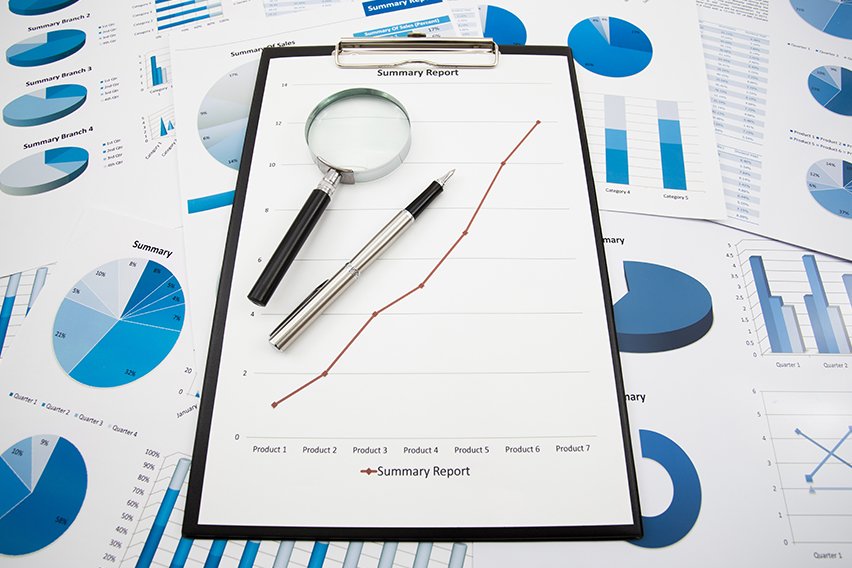Month End Close Process: Importance, Checklist & Best Practices

You want to protect your business against financial issues. To ensure that happens, your accounting department and finance team need to work together to create a month end close process.
This monthly closing process is a time-consuming task. But it’s crucial if you want to have precise and consistent financial data.
In this article, we’ll cover:
What Is the Month-End Close Process?
Why Is the Month-End Close Process Important?
Steps to Complete the Month End Close Process
Best Practices for a Month-End Close Process
What Is the Month-End Close Process?
The month end closing process is a procedure that accounts for all of the previous month’s financial transactions. Your accounting team reviews, records, and reconciles all relevant account information.
The exact nature of the month end close process varies from business to business. Each company has its own set of closing operations and activities. However, the following activities are fairly common across all organizations for a month end close:
- Record all un-entered invoices
- Account reconciliations for credit cards and bank cards
- An inventory count with reconciliations of any discrepancies
- Comparison between actual expenditure and the company’s budget
- Mortgage and insurance entries
- Data analysis and report preparation for investors and management
- Closing of the accounting period in the company’s accounting software
Ultimately, the goal of your finance and accounting teams is to create accurate financial statements for the month.

Why Is the Month-End Close Process Important?
The month end close process allows you to track all the transactions your business conducts during the month. That’s crucial for ensuring your accounting data is as accurate and complete as possible.
Accurate monthly data feeds into several other accounting procedures. For example, your year end close becomes a lot simpler if you have accurate monthly reports to work from.
We can distill the benefits of the month end close into the following:
- You create accurate and up-to-date financial records.
- As a small business owner, you can make more informed decisions based on your company’s financial activity.
- You save time on tax filing because your financial statements are in order.
- Audits become simpler because your reports streamline the process.
- The financial close process highlights areas that require improvement.
Steps to Complete the Month End Close Process
Certain steps help you complete the month end close process. Following them makes the process as simple as possible.
Step 1 – Record Monthly Expenses and Income
Ideally, your company should record expenses in real time. The following are key expenses to track:
- Insurance
- Payroll
- Payments to suppliers
- Utility bills
- Travel expenses
- Interest on bank loans
Furthermore, review your general ledger to ensure you’ve posted credit and debit entries correctly.
For income, you need to track your incoming cash items, including:
- Investment income
- Sales revenue
- Debt repayments made to your company
- Any other income you generate, such as rental income
It’s also worth checking your income statement accounts to ensure you’ve invoiced all of your customers for the month.
Step 2 – Update Accounts Payable and Accounts Receivable
Work through your accounting systems to ensure you’re making invoice payments on time. Use this opportunity to search for mistakes, such as duplicate invoices that could lead to overpayments.
For accounts receivable, ensure your customers pay within their agreed credit limits. You might find more opportunities for improvement here. For example, you might find that you can alter payment terms for your next accounting period. This action could improve the cash flow of your business.
Step 3 – Prepare Account Reconciliations
Account reconciliations help you spot mistakes in your financial reporting. You can also check your account statements for evidence of fraudulent transactions.
Reconcile your financial records with your bank accounts. Examine your checking and savings accounts, loan and credit accounts, and digital accounts, such as PayPal. Check your balances, deposits, and withdrawals to find discrepancies.
Step 4 – Check Your Petty Cash Fund
It’s easy to let transactions made from the petty cash fund go unrecorded. That can lead to discrepancies that show up on year-end reports.
Reconcile deposits and receipts for this fund to ensure your petty cash balance is what you expect it to be. It may be best to check this fund weekly to keep track of your small payments.
Step 5 – Review Your Inventory
Complete an inventory count and check the numbers against what you have in your books. If you find discrepancies, this is a trigger telling you that something needs to change with your processes.
Review your storage methods, how much inventory you hold, and how you pay for that inventory.
Step 6 – Check Fixed Assets
Fixed assets are the long-term assets your company holds. Examples include vehicles, buildings, and machinery. You also have intangible assets, such as your trademarks and brand name, to consider.
Track the condition of these assets and record any expenses related to them. Of course, you should account for purchases when you review fixed assets too. Review amortization and asset depreciation in this step as well.
Step 7 – Reconcile Your Prepaid and Accrued Accounts
Your prepaid accounts cover expenses you pay ahead of time. Accrued accounts cover your accrued expenses and revenue.
Reconcile the 2 to reflect expenses paid and income received for the month. Furthermore, check your prepaid accounts against your expense accounts to prevent duplicate payments.
Step 8 – Create Financial Statements
With all of your accounts reviewed, it’s time to prepare financial statements to review the following:
- Value
- Profitability
- Cash flow
These statements include your cash flow statement, balance sheets, and profit and loss statement. Usually a lot of businesses prepares monthly financial statements, you can use an accounting system that generates these reports automatically.
Show the reports to a CPA once they’re generated. They can analyze the numbers, check journal entries, and give some insight into your company’s financial health.
Step 9 – Review
You’ll parse through a lot of financial information during these account reconciliation processes. Mistakes may occur that cause inaccuracy in reports.
As such, it’s a good idea to ask somebody who didn’t prepare your accounts to take a look at them. Have this person check all financial statements, as well as your general ledger.
Step 10 – Implement Lessons
Now that you’ve collected your financial reports, you have an opportunity to make changes to your business. Corrective action is part of effective financial planning. It helps you with spend management and risk management, ensuring the company’s financial health.
Ask yourself these questions:
- What were the company’s successes and failures?
- Are there any month end processes I need to change?
- What issues do I need to address straight away?
- Is the company tracking well towards its long-term goals?
- What challenges do you see for the future?
Note that you’re not alone in answering these questions. Most accounting teams can provide answers due to their direct involvement in all the processes. Don’t be afraid to ask for advice from others.
How FreshBooks Can Help
It’s difficult for small business owners to keep track of all of their company’s financial data. You’re trying to stay on top of balance sheet accounts while tracking accounts payable, savings accounts, and so much more.
It’s a lot of work.
Work that FreshBooks can help you with. We provide the tools that support business owners. With our help, you can make invoicing easier and access integrations designed to streamline accounting. Over 30 million people have used FreshBooks worldwide. If you’d like to be one of them, our team is waiting to help you.
Month End Close Checklist
You have the core steps you should follow. Now you need a checklist that ensures you have all the data you need to complete those steps. This month end checklist helps you gather the information you need before your monthly close date.
Record Incoming Cash
No matter where the cash comes from, you need to have a record of it. That means verifying that you’ve sent invoices and cross-checking which invoices clients have paid.
Check Your Accounts Payable Records
Where is your company spending its money?
You can’t know the answer if you’re not tracking your accounts payable balance. Use accounting software to track spending automatically.
Reconcile Your Accounts
This is covered in the steps we shared earlier. Still, it’s always worth mentioning again. The entries in your financial statements must match the entries from bankers, vendors, and other entities.
Something’s gone wrong if they don’t.
Never Forget Petty Cash
The petty cash fund accounts for tiny purchases that are so easy to overlook. Develop workflows that allow for automatic processing and recording of petty cash transactions. You could go down the manual data entry route. Just know this opens the door to mistakes.
Collect Your Financial Information
You don’t want to find yourself halfway through a monthly close only to discover you’re missing crucial documents. Make sure you have the following:
- Balance sheet
- General ledger
- Profit and loss statement
Collectively, you can use these documents to create a trial balance. This is a listing of final balances across all of your accounts.
Plan Ahead
Don’t wait until the end of the month to start your month end close process.
Start planning today.
For example, ask where you can implement automation software to speed up your processes. Establish closing dates for reporting. Finally, implement processes to ensure your accounting and finance teams have what they need.
Also Read: How to Close Accounting Books
Best Practices for a Month-End Close Process
Your monthly closing process can feel like a hectic period. But by following appropriate practices, you can simplify the month end close process:
- Accuracy is always more important than closing quickly. You have 10 days after the month’s end to present your closing information. Use that time to ensure your data is as accurate as possible before your closing date.
- Managing time helps you to meet your deadlines. Set daily and weekly goals for your teams to serve the month end close process.
- Don’t allow silos to compromise your month end process. Your accounting team needs to understand every element of your business. That means they have to know who’s responsible for what so they can always talk to the right people.
- Building from the last point, the relationships inside your business matter. Good relationships make it easier for you to ask how people inside your business collect and report on data. They also make it easier for you to make recommendations when something has to change.

Key Takeaways
Some small business owners underestimate the importance of the month end close process. They may not see how tracking what happened during the previous month helps them set a company up for success in the future.
Don’t be one of those business owners.
The month end close process ensures you have information about your company’s financial standing. It’s crucial for helping you make short-term decisions, in addition to helping you work towards long-term goals. Plus, having accurate monthly reports makes your year-end close much simpler.
Frequently Asked Questions
How long should a month end close take?
Time management is a crucial challenge in a month’s end. You have a lot of processes to work through. Expect the close to take about 10 days to complete. However, you can cut that down to as little as 5 days if your accounting team has access to automation software.
What is month end reconciliation?
Month end reconciliation is another term for the month end close process. Some companies use the term because the month end close requires the reconciliation of a range of accounts.
How can month end closing be improved?
There are several ways you can improve your month end closing process:
- Automate wherever possible to decrease the amount of manual work your teams need to complete.
- Integrate disparate systems so your teams don’t have to deal with the errors that working from multiple systems can create.
- Always back up your data in case your primary systems fail. For example, you could store invoices locally and via the cloud.
- Try to upload data to your financial systems in real time. This ensures your finance and accounting teams don’t have to wait until the month’s end to start working.
How do you prepare month end accruals?
Follow these steps to prepare month end accruals:
- Gather all unpaid invoices from accounts payable.
- Contact all departments about any invoices they may have.
- Calculate how much your business plans to pay for each expense.
- Classify your invoices based on their account numbers.
- Debit expense accounts and credit accrual accounts. Repeat this process for all invoices.
RELATED ARTICLES

 Debits and Credits Cheat Sheet: A Handy Beginner’s Guide
Debits and Credits Cheat Sheet: A Handy Beginner’s Guide What Are Profitability Ratios? Definition, Types & Importance
What Are Profitability Ratios? Definition, Types & Importance Customer Profitability Analysis: Definition, Formula & How-to Guide
Customer Profitability Analysis: Definition, Formula & How-to Guide What Is a Good Current Ratio?
What Is a Good Current Ratio? Profitability Index: Definition & Calculation
Profitability Index: Definition & Calculation